
The wildlife of Armenia includes the wild boar, crested porcupine, various lizards, snakes and numerous species of birds and plants. Endangered species in Armenia are the bear, wild goat, Armenian mouflon and the leopard.

The wildlife of Armenia includes the wild boar, crested porcupine, various lizards, snakes and numerous species of birds and plants. Endangered species in Armenia are the bear, wild goat, Armenian mouflon and the leopard.

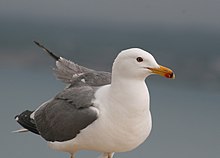
Fauna in Armenia is diverse given the country's relatively small size, owing to the varied habitats created by the area's mountainous terrain. Armenia is an important area for migratory animals, about 350 different bird species were recorded in the country. Many of the world's domesticated animals originated in or near Armenia, and the mouflon, the ancestor of domesticated sheep, is present there. Research suggests that about a quarter of the animal species in Armenia are internationally endangered. The mouflon is suffering a great population decline due to poaching and habitat loss, and the Sevan trout, which once made up thirty percent of the fish in Lake Sevan, have virtually disappeared.
Southern and south-western Armenia remains the last stronghold of the Persian leopard in the Caucasus, in part due to the region being connected with the leopard population in Iran. The total population in Armenia is thought to number 10 to 20 individuals, including adults, sub-adults and cubs. [1]

In Armenia forest cover is around 12% of the total land area, equivalent to 328,470 hectares (ha) of forest in 2020, down from 334,730 hectares (ha) in 1990. In 2020, naturally regenerating forest covered 310,000 hectares (ha) and planted forest covered 18,470 hectares (ha). Of the naturally regenerating forest 5% was reported to be primary forest (consisting of native tree species with no clearly visible indications of human activity) and around 0% of the forest area was found within protected areas. For the year 2015, 100% of the forest area was reported to be under public ownership. [2] [3]
Some flora found in Armenia includes:

The Caucasian moose, also known as the Caucasian elk is an extinct subspecies of moose found in the Caucasus Mountains of Eastern Europe and Asia Minor, in modern-day European Russia, Armenia, Azerbaijan, Georgia, and eastern Turkey and north and west iran.

Fauna of Azerbaijan or animal kingdom of Azerbaijan refers to the diversity of various types of animals, which inhabit and populate a defined ground or water area in Azerbaijan.

Fauna in Armenia is diverse given the country's relatively small geographic size, owing to the varied habitats created by the area's mountainous terrain. Armenia is an important area for migratory animals; about 350 different bird species were recorded in the country. Many of the world's domesticated animals originated in the area Armenia is located in, and the mouflon, the ancestor of domesticated sheep, is present there. Research suggests that about a quarter of the animal species in Armenia are internationally endangered. The mouflons are suffering a great population decline due to poaching and habitat loss, and the Sevan trout, which made up thirty percent of the fish in Lake Sevan, have virtually disappeared.
National parks of Azerbaijan are run by the Ministry of Ecology and Natural Resources in the Republic of Azerbaijan. The first national park established was Zangezur National Park in 2003. Since then, a further 9 national parks have been established; the most recent being the Gizilaghaj National Park in 2018.

Hirkan National Park is a national park in Azerbaijan, in the Talysh region. It was established in an area in Lankaran Rayon and Astara Rayon administrative districts on February 9, 2004 on the basis of the former "Hirkan State Reserve" which it superseded, on a surface area of 29,760 hectares (297.6 km2). It was enlarged by presidential decree on April 23, 2008 from 29,760 hectares (297.6 km2) to 40,358 hectares (403.58 km2).
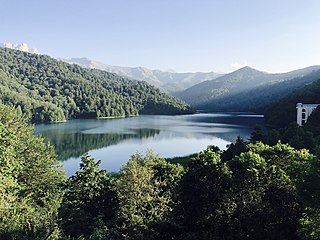
Göygöl National Park — is a national park of Azerbaijan. It was established in an area in Goygol Rayon administrative district on April 1, 2008, on the basis of the former "Goy Gol State Reserve" that was established in 1925 and which it superseded, on a surface area of 12,755 hectares (127.55 km2). It was enlarged from 6,739 hectares (67.39 km2) of the former state reserve to its current surface area as a national park. The park is the most visited in the country.
The wildlife of Iran include the fauna and flora of Iran.

The wildlife of Azerbaijan consists of its flora and fauna and their natural habitats.

The wildlife of Algeria is composed of its flora and fauna. Mountains, chotts, wetlands, and grassy desert-like regions all support a wide range of wildlife. The most commonly seen animals include the wild boars, jackals, and gazelles, although it is not uncommon to spot fennecs and jerboas. Leopards and cheetahs are seldom seen.

Vashlovani National Park is a national park located in the eastern part of Georgia, and was established in 1935 to preserve its unique shallow forests. In April 2003 the reserve's area was expanded to 84.80 km2 (32.74 sq mi) and Vashlovani National Park was made.

Shvanidzor is a village in the Meghri Municipality of the Syunik Province in southeastern Armenia, near Armenia's border with Iran.

The Hyrcanian forests are a zone of lush lowland and montane forests covering about 55,000 square kilometres (21,000 sq mi) near the shores of the Caspian Sea in Iran and Azerbaijan. The forest is named after the ancient region of Hyrcania. The World Wide Fund for Nature refers to the ecoregion as the Caspian Hyrcanian mixed forests. Since 5 July 2019, the Hyrcanian Forests have been designated a UNESCO World Heritage Site. In September 2023, the heritage site expanded to incorporate portions of the forest located in Azerbaijan.
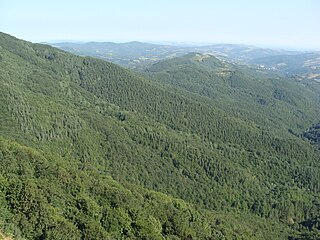
The Bulgarka Natural Park is a Bulgarian nature park on the northern slopes of the Balkan Mountains, occupying 22,000 hectares of territory in the central and eastern part of the mountains between the cities of Gabrovo and Kazanluk.
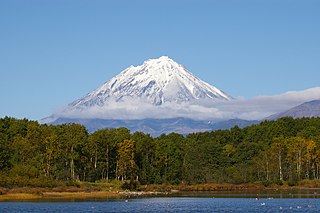
The wildlife of Russia inhabits terrain that extends across 12 time zones and from the tundra region in the far north to the Caucasus Mountains and prairies in the south, including temperate forests which cover 70% of the country. Russia's forests comprise 22% of the forest in the world as well as 33% of all temperate forest.

Khosrov Forest State Reserve, is a nature reserve in Ararat Province of Armenia. The reserve is one of the oldest protected areas in the world having a history of about 1,700 years. It was founded in the 4th century (334–338) by the order of king Khosrov Kotak, who gave it his name. It was founded to improve the natural climatic conditions of adjacent territories of Artashat – the capital city of Armenia of the given period and the newly established city of Dvin to ensure conservation and enrichment of flora and fauna; serve as a ground for royal hunting, military exercises and entertainment.
The Geno Biosphere Reserve, with a total area of 27,500 hectares, situated in the Hormozgan province of Iran. It has been designated as a protected area by the Iranian Department of Environment in 1976.

The wildlife of Chechnya includes a range of flora, fauna, and funga as reflected by its varying topographic and climatic conditions, with the Greater Caucasus to the south, the foreland zone the Terek and Sunza river valleys in the west and east, and the rolling plains of Nogai steppe in the north. Lake Kezenoyam in Chechnya is near the border with Dagestan and can sustain plankton growth. Salmo ezenami, a rare species of trout now critically endangered due to introduction of the invasive species European chub, is native only to this lake and is therefore endemic to Lake Kezenoyam.

The Tusheti National Park in eastern Georgia is one of the eight new protected areas approved by Parliament of Georgia on 22 April 2003.
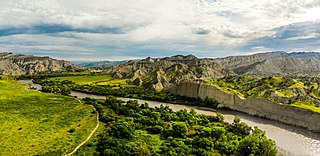
Vashlovani Strict Nature Reserve is a protected area in Dedoplistsqaro Municipality, Kakheti region of Georgia on Shiraqi mountain range and Georgian bank of Alazani River, at elevation 300-600 meters above sea level.

Chachuna Managed Reserve is a protected area in the Dedoplistskaro Municipality in Kakheti region of Georgia in the south-eastern part of the country near the border with Azerbaijan in floodplains of Iori River. Chachuna Managed Reserve was established in order to protect forests on the banks of the Iori river and Dalis-Mta reservoir and it characteristic arid and semi-arid types of flora and fauna. On the reserve territory there are several bird hides for birdwatching. Chachuni Managed Reserve was established in 1996 mostly on the territory of former Chachuni State Forestry which was in existence since 1965. The Administration of Chachuna Managed Reserve is located in Dedoplistskaro in shared facility with Vashlovani Protected Areas Administration.
Additional sources